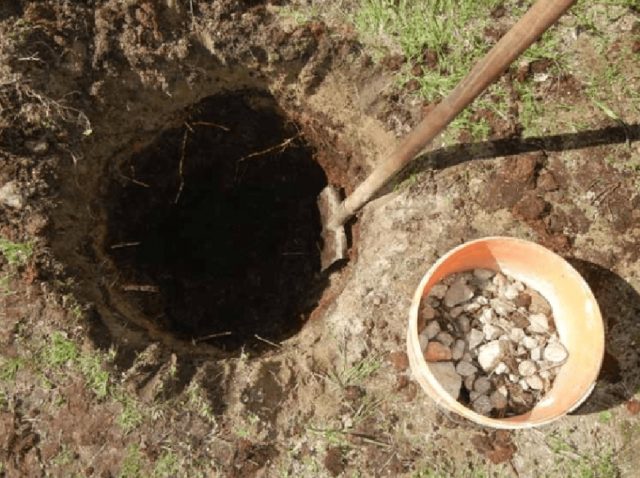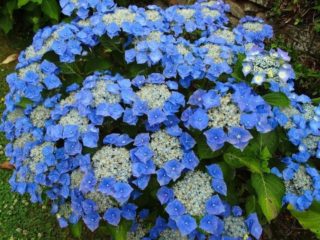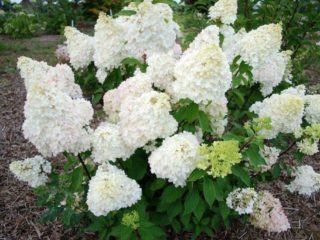Content
Hydrangea large-leaved Aisha is one of the representatives of moisture-loving shrubs. Differs in very beautiful flowering and decorative leaves. It is often grown not only in the garden, but also indoors. In any case, it retains its attractiveness for a long time.
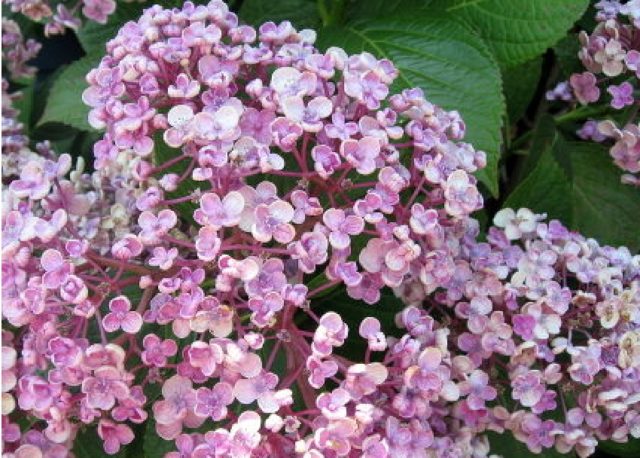
The beauty of blooming Aisha will not leave anyone indifferent
Description of hydrangea Aisha
This variety is an upright shrub with excellent external characteristics:
- The bush is undersized, in adulthood Aisha reaches 1.2 m, the crown width is up to 1.5 m in diameter. Annual growth up to 25 cm.
- Aisha's hydrangea shoots are densely leafy. All branches of the current year are green. They become woody the next year, therefore woody ones are always last year. It is this fact that is the reason for the weak frost resistance of Aisha's hydrangea.
- The leaves are green, oval in shape with jagged ends. The second option is wavy around the edges. Quite large in size.
- The flowers of Aisha's hydrangea are very decorative, they form on the shoots of the last year, unlike other types of hydrangeas. The shape of the flowers is spherical, the diameter of one reaches 3 cm. The color changes during the opening process. Initially, they have a creamy white tint, then they turn pink or blue. The final color depends on the acidity of the soil. Some specimens are very similar in shape to the petals of lilac flowers. The aroma is light and delicate, which is the hallmark of the Aisha variety. Hydrangea flowers are usually odorless.
- Aisha's inflorescences are domed and large, ideal for cutting. The diameter of one is 20-25 cm.
- The seeds ripen in a capsule, the size of the seeds is very small. One contains a large amount of hydrangea seeds.
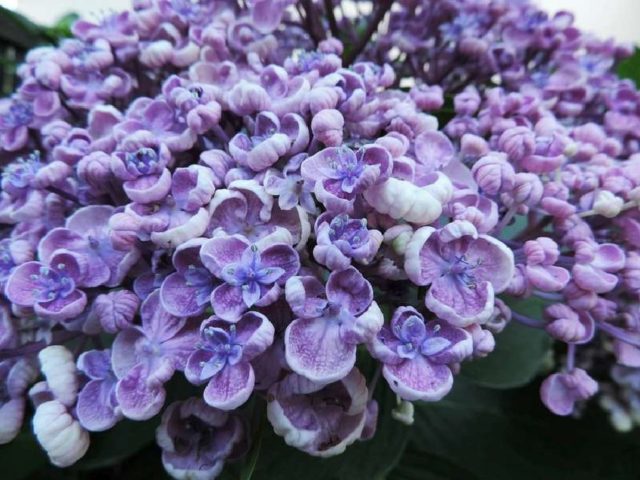
By adjusting the acidity of the soil, amazing color changes can be observed
Hydrangea Aisha in landscape design
The shape and decorativeness of the variety make it possible to use the plant as a specimen, also for decorating group plantings. Aisha goes well with other types of hydrangeas, so groups can be formed from one species or from several. The originality of the composition is given in the form of container plants. Looks harmoniously with trees and other shrubs. Of the garden plants for the hydrangea partnership, Aisha prefers rhododendrons or holly. Designers recommend using ivy, periwinkle, hostu, fern or anemone... The Aisha hedge looks great.

Hydrangea border will decorate any area
The plant lives up to 50 years, which must also be taken into account when placing it on the site.
Winter hardiness of hydrangea Aisha
The demanding culture for air temperature is well known to gardeners. This is due to:
- the close location of the roots to the soil surface;
- lignification of shoots only for the next year;
- the laying of flower buds in the first cycle of life.
In severe frosts, hydrangea freezes easily. The optimum temperature that the plant will tolerate without any significant damage is - 18 ° C. This mark is taken into account only if the bush is insulated, at least similar to roses.If the hydrangea freezes, then it will no longer bloom next year. Can please the gardener with lush foliage, no more. Therefore, it is necessary to prepare Aisha for winter in regions with a cool climate.
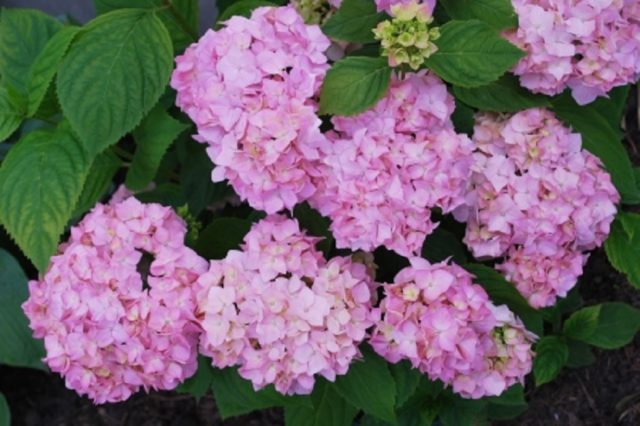
Aisha's hydrangea retains its magnificent decorativeness only with appropriate shelter for the winter.
Planting and caring for Aisha's hydrangea
Planting Aisha is an important stage in the life of a shrub. The further development of the plant depends on how competently it will be carried out. The second period, no less important for the gardener, is leaving before the end of the growing season. To carry out these phases correctly, you need to familiarize yourself with the nuances and take a responsible approach to each event:
- choosing a place and preparing it for planting hydrangeas;
- fulfillment of all the nuances of the Aisha planting process;
- compliance with the requirements of agricultural technology for the care of shrubs.
Each has its own subtleties, knowledge of which is necessary.
Selection and preparation of the landing site
In order for the hydrangea to develop well and bloom magnificently, you need to pick up a site with partial shade. It is best if the plant will be well lit in the morning, and then be in the "openwork shade". The bright sun reduces the color saturation of the flowers. Aisha should not be placed close to trees. Hydrangea absorbs a lot of moisture, and with such a neighborhood you will have to compete.
The soil for Aisha's hydrangea must be fertile and drained. The presence of lime in it is unacceptable. Alkaline soil is not suitable for culture. It is optimal to plant a large-leaved hydrangea in a soil with a slightly acidic or medium acidic environment. Such acidity will be provided by a mixture of leafy soil, turf, peat and sand in equal proportions. It is imperative to prepare a drainage system for Aisha.
Landing rules
Hydrangea large-leaved hydrangea macrophylla ayesha tolerates planting well. The best time is the end of spring, when the threat of frost has passed. The whole process for an experienced gardener takes a little time. Beginners will first have to familiarize themselves with the sequence of actions:
- Dig a hole of equal depth and width. Parameters range from 30 cm to 70 cm, they depend on the size of the root system or coma. The distance between the pits must be at least 2 m.
The pit must be of sufficient size and always with a drainage layer
- Lay drainage.
- Fill in part of the prepared soil mixture.
- Install Aisha's seedling, cover the roots with the remaining soil mixture.Important! Do not bury the root collar, leave it at ground level.
- Slightly compact the ground, water Aisha's hydrangea seedling.
- It is imperative to mulch the periosteal circle. Lay a layer of mulch at least 10-12 cm.
A good material for mulch is needles or sawdust.
Watering and feeding
The growth and decorativeness of Aisha's hydrangea directly depend on the irrigation schedule. If the shrub is watered untimely or not enough, then the hydrangea will immediately react with the loss of its attractiveness and will cease to please with lush flowering. The inflorescences will become faded and drooping. Watering the large-leaved hydrangea is necessary with settled warm water. Experienced gardeners are advised to have a container for water on the site so that it heats up naturally. However, care must be taken to avoid overheating. Periodically (once a month), you can water the hydrangea with a solution of citric acid, having previously measured the acidity index.
Top dressing for the bush is applied throughout the growing season with an interval of 14 days. It is imperative to alternate mineral complexes with organic matter. It is important to remember that the hydrangea cannot be fed with ash, manure or humus. The plant does not like these substances. When signs of chlorosis appear, it is necessary to feed Aisha's hydrangea with a solution of iron salts at least 3 times at intervals after 7 days. The main dressing is considered spring in the budding phase and autumn in preparation for winter.
Pruning hydrangea large-leaved Aisha
There is no need to prune the shrub. You only need a sanitary cutting of dry and broken branches.The second option is to give the desired geometric shape to the crown of Aisha's hydrangea. For the first 2 years, the plant should not be touched so that the hydrangea can grow the required volume of branches. You can trim shoots in spring or autumn. When the active growing season comes, it is not recommended to touch Aisha.
Preparing for winter
In order for the hydrangea to survive the winter, measures must be taken to insulate the bush. First, you need good hydration. Secondly - spraying the branches with a Bordeaux mixture from the appearance of diaper rash. As soon as the time for night frosts comes, you need to do the following:
- Spud the bush with a layer of 20-30 cm.
- Cover the top with two layers of agrospan or similar material.
- Bend the branches to the ground, cover with dry foliage or spruce branches.
- Cover the bush with a box or box.
It is necessary to remove the shelter in the spring only after warm weather sets in and the threat of frost passes.
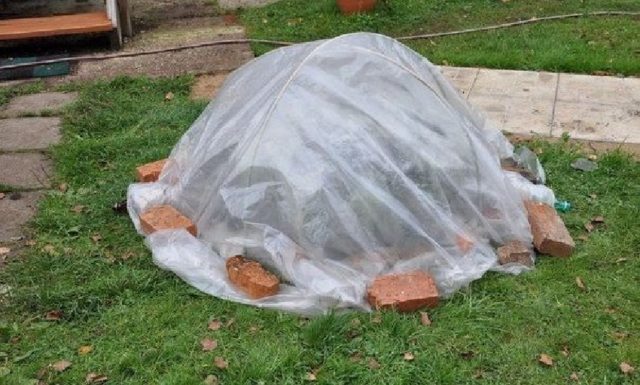
A competent shelter will allow you to keep the flowering of the bush for the next year.
Reproduction
According to the recommendations of gardeners, the best way to propagate large-leaved hydrangea is cuttings. If the event is held in the summer, then green shoots. Lignified cuttings in winter. Parts of the shoots take root quite actively. After planting, with proper care, Aisha blooms the next year. Reproduction by layers and seeds is considered less popular. It will be easier to divide the bush when transplanting. This way, you can also get full-fledged plants that will bloom in spring.
Diseases and pests
The shrub can be affected by fungal infections. When oily yellow spots appear on the leaves, you need to treat the plant with a fungicide. This is a symptom of downy mildew, which spreads very quickly. If you do not take protective measures, the plant will die.
The second type of disease that occurs quite often is chlorosis. The reason is feeding the bush with humus or alkalization of the soil. It is necessary to increase the acidity and revise the feeding schedule.
With a lack of moisture, a spider mite settles on hydrangeas. You need to fight the pest by spraying with an insecticide, for example, Aktellik. Repeat the treatment after 5 days until the tick is destroyed.
Conclusion
Hydrangea large-leaved Aisha is a real decoration of the garden plot. Observing agrotechnical recommendations, even a novice florist is able to grow an ornamental shrub on his own.
